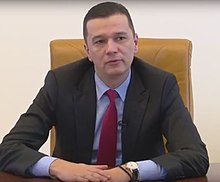Prime Minister of Romania
| Prime Minister of Romania | |
|---|---|

Standard of the Prime Minister of Romania
|
|
| Residence | Victoria Palace |
| Appointer | President of Romania |
| Term length | No fixed term |
| Inaugural holder | Barbu Catargiu |
| Formation | 22 January 1862 |
| Salary | 15,108 lei (2015) |
| Website | www.guv.ro/prim-ministru |
The Prime Minister of Romania (Romanian: Prim-ministrul României) is the head of the Government of Romania. Initially, the office was styled President of the Council of Ministers (Romanian: Președintele Consiliului de Miniștri), when the term "Government" included more than the Cabinet, and the Cabinet was called The Council of Ministers (Consiliul de Miniștri). The title was officially changed to Prime Minister during the communist regime.
Sorin Grindeanu has been the incumbent prime minister since 4 January 2017.
One of the roles of the President of the Republic is to designate a candidate for the office of Prime Minister. The President must consult with the party that has the majority in the Parliament or, if no such majority exists, with the parties represented in Parliament.
Once designated, the candidate assembles a proposal for the governing program and the cabinet. The proposal must be approved by the Parliament within ten days, through a vote of confidence process. Both the program and the cabinet membership are debated by the Parliament in a joint session of the Chamber of Deputies and the Senate. The proposal is accepted only if a majority of all Deputies and Senators approves.
Once the vote of confidence is obtained, the candidate becomes the Prime Minister and all cabinet members become Ministers. The Prime Minister, the Ministers, and other members of the Government take an oath before the President, as stipulated under Article 82 of the Constitution. The Government as a whole and each of its members exercise their mandate from the date of the oath.
The Prime Minister directs Government actions and co-ordinates the activities of its members. He submits to the Chamber of Deputies or the Senate reports and statements on Government policy, to be debated. The President cannot dismiss the Prime Minister, but the Parliament can withdraw its support through a vote of no-confidence.
...
Wikipedia

